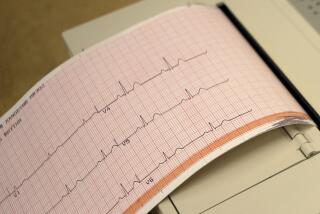A Folder Full of X-Rays and Computer Printouts, Not a 20-Year-Old Squirming in Pain
- Share via
A year ago I slipped into the grip of modern medical technology. Today I am celebrating the impossible: I am alive.
Last January I developed stomach pains. Soon they became so intolerable that even codeine gave me no relief. The pain was diffused throughout my abdomen; it was sharp and constant. Food and water caused me to vomit. I had severe chills and a high fever. Within a few days I developed a second pain in my lower back.
I checked into a university hospital, and for two weeks was subjected to a staggering number of tests--blood tests and X-rays by the dozen, scans, an endoscopy, a barium enema, an upper GI series, two ultrasounds, a bone scan and a white blood-cell scan. None of the tests revealed the source of my pain. My fever persisted, and other signs of raging infection got worse. I was dying. But with the cause unknown, there was no treatment.
Now that a year has passed since my recovery, I have a more objective understanding of my illness. I recall that the tests themselves caused some of my worst misery. I was subjected to a painful barium enema when my resistance to pain and discomfort was already unacceptably low. After my system had rejected oral fluid intake for almost two weeks, I had to swallow a gallon of barium-laced “lemonade” for my CAT-scan. And since I was already depressed and prone to fits of crying, I had no ability to fight the claustrophobia that seemed inevitable in the closed barrel of an MRI (magnetic-resonance imaging) scanner; my time in that coffin-like tube was the worst hour of my life.
Though I was in absolute agony as I lay alone in my hospital room, it was the barrage of torturous procedures that pushed me to the point of complete hysteria.
Modern medicine and technology go hand-in-hand. Nobody can deny that such technological advances as the CAT-scan and MRI have revolutionized medicine and accordingly have improved the entire human condition. But with all technology there is the risk of dehumanization: I became a folder full of X-rays and computer printouts, and not a 20-year old squirming in pain.
My doctors were impotent, it seemed to me, because they were not examining me so much as they were examining pictures of me. My pain, while growing worse for me, had become a constant to them. The elusive cause was all, not the effect, which was a person in agony.
Medicine is an inexact science. How can computers and scanners be expected to always provide precise answers to questions that are inherently inexact? The physician is necessary in any diagnosis.
While I was sick, my father, who is a physician, outlined my case to a physician with whom he had worked many years ago. This doctor is an old man now; he no longer practices. But he is from a generation of doctors who had to rely on their medical intellect and savvy to make diagnoses. “Your son,” he told my dad, “has a ruptured appendix.”
When my father told my doctors about the older physician’s opinion, they simply responded that none of my tests had shown a ruptured appendix.
After four weeks the tests finally indicated something that suggested an intestinal blockage.
It was only during an abortive bowel resection that the surgeon found the source cause of my misery: a ruptured retrocecal appendix. My doctors had not detected it for four weeks.
As a pre-medical college student who had became a patient in a teaching hospital, I gained great respect for the training process; the purpose clearly was to hone the young doctors’ medical intellect and instinct. Unfortunately, it seemed to me as the patient, the ideals reflected in this process were too easily violated in a quixotic attempt to find a wonder scanner that would instantly reveal all of the answers to my problem. In the end, this attitude almost killed me. And it was extremely expensive.
I have heard many people in the field explain that, legally, they are required to explore every possible avenue in order to restore a patient to health; these days, that means using whatever high-tech equipment is available. I don’t think that is necessary.
In legal jargon, the physician should send the patient to the radiology suite only when there is “probable cause.” Technology alone, no matter how advanced, cannot be expected to provide all of the answers every time.
I’m living proof of that.






